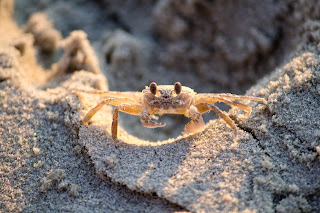When strolling along the pristine shores of a sandy beach, you might come across peculiar formations in the sand, like small tunnels leading down to the ocean. These intriguing structures are the work of nature’s engineers, the ghost crabs. In this article, we’ll delve into the world of these tiny crustaceans and explore the reasons behind their remarkable ability to build sand tunnels.
 |
| Ghost Crabs. Photo by Bonnie Kittle |
The Enigmatic Ghost Crab
1. Meet the Ghost Crab
Ghost crabs, scientifically known as Ocypode spp., are small crabs found in tropical and subtropical coastal regions worldwide. Their name is derived from their pale coloration and nocturnal habits, which give them an almost ghostly appearance against the sandy backdrop.
2. A Nighttime Mystery
Ghost crabs are primarily nocturnal creatures. They emerge from their burrows at night to forage for food, scuttling across the beach with remarkable agility. Their ability to navigate through darkness is fascinating, but it’s their burrowing behavior that truly captures our attention.
The Intricate Art of Burrow Construction
3. Building a Home
Ghost crabs are diligent architects, constructing burrows in the sand that serve as their homes and provide protection from predators and the harsh elements. These burrows are essential for their survival.
4. Tunnel Structure
Ghost crab burrows consist of a vertical shaft leading to a series of underground tunnels. These tunnels can extend up to several feet deep, offering the crab a safe haven to rest during the day and retreat to when danger approaches.
5. Sandcastle Builders
Ghost crabs have an astonishing ability to create sand pellets while digging their burrows, which they transport outside and form into small sandballs. These sandballs serve as a deterrent to potential intruders, as they can be thrown at predators or rivals.
The Why Behind the What
6. Thermoregulation
One of the primary reasons ghost crabs build sand tunnels is to regulate their body temperature. The coastal environment can be extremely hot during the day and chilly at night. By retreating into their burrows during the scorching daytime hours, ghost crabs avoid overheating and conserve moisture.
7. A Safe Hideout
Predators like birds and larger crabs often prowl the shoreline, searching for a tasty meal. Ghost crabs retreat to their burrows to escape these threats and reduce their risk of becoming someone else’s lunch.
8. Mating and Reproduction
Ghost crab burrows also play a vital role in their reproductive cycle. These burrows serve as the perfect location for courtship and mating. Female ghost crabs select mates with well-constructed burrows, ensuring their offspring have a safe and secure environment.
9. The Ghostly Hunt
Ghost crabs are omnivorous scavengers. They forage for algae, detritus, and small invertebrates along the beach. The sand tunnels allow them to ambush prey and quickly retreat to safety.
Conservation Concerns
10. Impact of Human Activity
As coastal development continues to encroach on ghost crab habitats, these remarkable creatures face threats to their existence. Destruction of their burrows can disrupt their life cycle and lead to population declines.
11. Protecting Ghost Crab Habitats
Conservation efforts are essential to ensure the survival of ghost crabs and the preservation of their unique sand tunnel habitats. Education and responsible coastal management are crucial steps in protecting these fascinating creatures.
Ghost crabs, with their nocturnal habits and sand tunnel-building prowess, are a testament to the marvels of nature. Their ability to thrive in the challenging coastal environment, using their burrows for various purposes, is a true wonder. As we continue to explore and appreciate the natural world, let us also strive to protect the habitats of these captivating creatures.
Yesterday, I visited the beach with the sole purpose of capturing some scenic moments for my YouTube channel. To my delight, I stumbled upon a fascinating sight: numerous crabs busy digging into the sand to construct their nests along the shoreline.
They seemed to be engaged in a playful game of chase, creating an intriguing spectacle. Additionally, I observed a myriad of small animals engaging in various activities, all of which contributed to the complexity of the video footage. I invite you to watch these captivating videos below, as I am confident you will thoroughly enjoy them.
Crab Digging Sand To Build Nest video:
FAQs (Frequently Asked Questions)
1. Are ghost crab burrows harmful to beaches?
Ghost crab burrows are a natural part of the coastal ecosystem and are not harmful to beaches. In fact, they help aerate the sand and contribute to the overall health of the shoreline.
2. How deep can ghost crab burrows go?
Ghost crab burrows can extend several feet deep, with some reaching depths of up to four feet or more, depending on the specific species and environmental conditions.
3. Do ghost crabs eat fish?
No, ghost crabs primarily feed on detritus, algae, and small invertebrates found along the shoreline. They are not known to eat fish.
4. Can I observe ghost crabs building their burrows at night?
Yes, you can observe ghost crabs building their burrows at night on many sandy beaches. Remember to bring a red flashlight, as white light can disturb their nocturnal activities.
5. How can I contribute to ghost crab conservation efforts?
You can contribute to ghost crab conservation by supporting local initiatives that protect coastal habitats, advocating for responsible coastal development, and educating others about the importance of these fascinating creatures in the ecosystem.